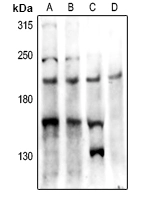
WB analysis of various samples using GTX55884 PTP kappa antibody. Lane A: HCT116 whole cell lysate Lane B: A549 whole cell lysate Lane C: mouse lung tissue lysate Lane D: rat brain tissue lysate
PTP kappa antibody
GTX55884
ApplicationsWestern Blot
Product group Antibodies
ReactivityHuman, Mouse, Rat
TargetPTPRK
Overview
- SupplierGeneTex
- Product NamePTP kappa antibody
- Delivery Days Customer9
- Application Supplier NoteWB: 1:500 - 1:1000. *Optimal dilutions/concentrations should be determined by the researcher.Not tested in other applications.
- ApplicationsWestern Blot
- CertificationResearch Use Only
- ClonalityPolyclonal
- ConjugateUnconjugated
- Gene ID5796
- Target namePTPRK
- Target descriptionprotein tyrosine phosphatase receptor type K
- Target synonymsdJ480J14.2.1 (protein tyrosine phosphatase, receptor type, K (R-PTP-KAPPA, protein tyrosine phosphatase kappa , protein tyrosine phosphatase kappa; protein-tyrosine phosphatase kappa; protein-tyrosine phosphatase, receptor type, kappa; receptor-type tyrosine-protein phosphatase kappa; R-PTP-kappa
- HostRabbit
- IsotypeIgG
- Protein IDQ15262
- Protein NameReceptor-type tyrosine-protein phosphatase kappa
- Scientific DescriptionThe protein encoded by this gene is a member of the protein tyrosine phosphatase (PTP) family. PTPs are known to be signaling molecules that regulate a variety of cellular processes including cell growth, differentiation, mitotic cycle, and oncogenic transformation. This PTP possesses an extracellular region, a single transmembrane region, and two tandem catalytic domains, and thus represents a receptor-type PTP. The extracellular region contains a meprin-A5 antigen-PTP mu (MAM) domain, an Ig-like domain and four fibronectin type III-like repeats. This PTP was shown to mediate homophilic intercellular interaction, possibly through the interaction with beta- and gamma-catenin at adherens junctions. Expression of this gene was found to be stimulated by TGF-beta 1, which may be important for the inhibition of keratinocyte proliferation. [provided by RefSeq, Jul 2008]
- ReactivityHuman, Mouse, Rat
- Storage Instruction-20°C or -80°C,2°C to 8°C
- UNSPSC12352203
